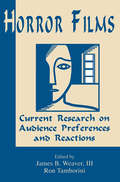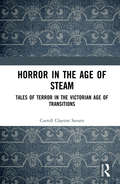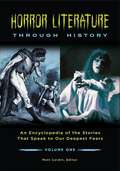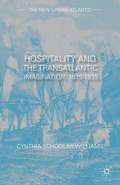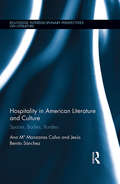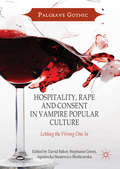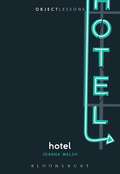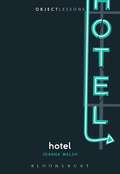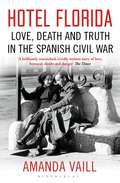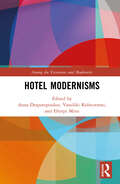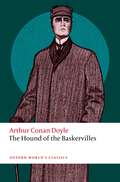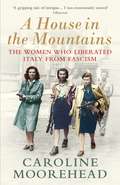- Table View
- List View
Horror Films: Current Research on Audience Preferences and Reactions (Routledge Communication Series)
by Ron Tamborini James B. WeaverWhy do so many of us enjoy being told frightening stories? What are some of the consequences that result from such exposure? In light of the considerable popularity of horror films over the last three decades, these questions have become the focus of growing attention for many scholars. However, research on audience preferences for, and reactions to, horror films has been performed eclectically by investigators from varied theoretical and methodological backgrounds. As a result, the information has not been effectively integrated. This volume was written to address this problem and to position the study of audience responses to frightening fiction as a significant research topic.
Horror Films: Current Research on Audience Preferences and Reactions (Routledge Communication Series)
by James B. Weaver Iii Ron TamburiniWhy do so many of us enjoy being told frightening stories? What are some of the consequences that result from such exposure? In light of the considerable popularity of horror films over the last three decades, these questions have become the focus of growing attention for many scholars. However, research on audience preferences for, and reactions to, horror films has been performed eclectically by investigators from varied theoretical and methodological backgrounds. As a result, the information has not been effectively integrated. This volume was written to address this problem and to position the study of audience responses to frightening fiction as a significant research topic.
Horror in the Age of Steam: Tales of Terror in the Victorian Age of Transitions
by Carroll Clayton SavantChange is terrifying, and rapid change, within a small amount of time, is destabilizing to any culture. England, under the tutelage of Queen Victoria, witnessed precipitous change the likes of which it had not encountered in generations. Wholesale swaths of the economy and the social structure underwent complete recalibration, through the hands of economic progress, industrial innovation, scientific discovery, and social cohesiveness. Faced with such change, Britons had to redefine the concept of work, belief, and even what it meant to be English. Victorians relied on many methods to attempt to release the steam from the anxieties incurred through change, and one of those methods was the horror story of everyday existence during an age of transition. This book is a study of how authors Elizabeth Gaskell, Emily Brontë, and Anne Brontë turned to horrifying representations of everyday reality to illustrate the psychological-traumatic terrors of an age of transition
Horror in the Age of Steam: Tales of Terror in the Victorian Age of Transitions
by Carroll Clayton SavantChange is terrifying, and rapid change, within a small amount of time, is destabilizing to any culture. England, under the tutelage of Queen Victoria, witnessed precipitous change the likes of which it had not encountered in generations. Wholesale swaths of the economy and the social structure underwent complete recalibration, through the hands of economic progress, industrial innovation, scientific discovery, and social cohesiveness. Faced with such change, Britons had to redefine the concept of work, belief, and even what it meant to be English. Victorians relied on many methods to attempt to release the steam from the anxieties incurred through change, and one of those methods was the horror story of everyday existence during an age of transition. This book is a study of how authors Elizabeth Gaskell, Emily Brontë, and Anne Brontë turned to horrifying representations of everyday reality to illustrate the psychological-traumatic terrors of an age of transition
Horror Literature through History [2 volumes]: An Encyclopedia of the Stories That Speak to Our Deepest Fears [2 volumes]
by Editor Matt CardinThis two-volume set offers comprehensive coverage of horror literature that spans its deep history, dominant themes, significant works, and major authors, such as Stephen King, Edgar Allan Poe, and Anne Rice, as well as lesser-known horror writers.Many of today's horror story fans—who appreciate horror through movies, television, video games, graphic novels, and other forms—probably don't realize that horror literature is not only one of the most popular types of literature but one of the oldest. People have always been mesmerized by stories that speak to their deepest fears. Horror Literature through History shows 21st-century horror fans the literary sources of their favorite entertainment and the rich intrinsic value of horror literature in its own right. Through profiles of major authors, critical analyses of important works, and overview essays focused on horror during particular periods as well as on related issues such as religion, apocalypticism, social criticism, and gender, readers will discover the fascinating early roots and evolution of horror writings as well as the reciprocal influence of horror literature and horror cinema.This unique two-volume reference set provides wide coverage that is current and compelling to modern readers—who are of course also eager consumers of entertainment. In the first section, overview essays on horror during different historical periods situate works of horror literature within the social, cultural, historical, and intellectual currents of their respective eras, creating a seamless narrative of the genre's evolution from ancient times to the present. The second section demonstrates how otherwise unrelated works of horror have influenced each other, how horror subgenres have evolved, and how a broad range of topics within horror—such as ghosts, vampires, religion, and gender roles—have been handled across time. The set also provides alphabetically arranged reference entries on authors, works, and specialized topics that enable readers to zero in on information and concepts presented in the other sections.
Horror Literature through History [2 volumes]: An Encyclopedia of the Stories That Speak to Our Deepest Fears [2 volumes]
This two-volume set offers comprehensive coverage of horror literature that spans its deep history, dominant themes, significant works, and major authors, such as Stephen King, Edgar Allan Poe, and Anne Rice, as well as lesser-known horror writers.Many of today's horror story fans—who appreciate horror through movies, television, video games, graphic novels, and other forms—probably don't realize that horror literature is not only one of the most popular types of literature but one of the oldest. People have always been mesmerized by stories that speak to their deepest fears. Horror Literature through History shows 21st-century horror fans the literary sources of their favorite entertainment and the rich intrinsic value of horror literature in its own right. Through profiles of major authors, critical analyses of important works, and overview essays focused on horror during particular periods as well as on related issues such as religion, apocalypticism, social criticism, and gender, readers will discover the fascinating early roots and evolution of horror writings as well as the reciprocal influence of horror literature and horror cinema.This unique two-volume reference set provides wide coverage that is current and compelling to modern readers—who are of course also eager consumers of entertainment. In the first section, overview essays on horror during different historical periods situate works of horror literature within the social, cultural, historical, and intellectual currents of their respective eras, creating a seamless narrative of the genre's evolution from ancient times to the present. The second section demonstrates how otherwise unrelated works of horror have influenced each other, how horror subgenres have evolved, and how a broad range of topics within horror—such as ghosts, vampires, religion, and gender roles—have been handled across time. The set also provides alphabetically arranged reference entries on authors, works, and specialized topics that enable readers to zero in on information and concepts presented in the other sections.
The Horror Plays of the English Restoration (Studies in Performance and Early Modern Drama)
by Anne HermansonA decade after the Restoration of Charles II, a disturbing group of tragedies, dubbed by modern critics the horror or the blood-and-torture villain tragedies, burst onto the London stage. Ten years later they were gone - absorbed into the partisan frenzy which enveloped the theatre at the height of the Exclusion Crisis. Despite burgeoning interest, until now there has been no full investigation into why these deeply unsettling plays were written when they were and why they so fascinated audiences for the period that they held the stage. The author’s contention is that the genre of horror gains its popularity at times of social dislocation. It reflects deep schisms in society, and English society was profoundly unsettled and in a (delayed) state of shock from years of social upheaval and civil conflict. Through recurrent images of monstrosity, madness, venereal disease, incest and atheism, Hermanson argues that the horror dramatists trope deep-seated and unresolved anxieties - engaging profoundly with contemporary discourse by abreacting the conspiratorial climate of suspicion and fear. Some go as far as to question unequivocally the moral and political value of monarchy, vilifying the office of kingship and pushing ideas of atheism further than in any drama produced since Seneca. This study marks the first comprehensive investigation of these macabre tragedies in which playwrights such as Nathaniel Lee, Thomas Shadwell, Elkanah Settle, Thomas Otway and the Earl of Rochester take their audience on an exploration of human iniquity, thrusting them into an examination of man’s relationship to God, power, justice and evil.
The Horror Plays of the English Restoration (Studies in Performance and Early Modern Drama)
by Anne HermansonA decade after the Restoration of Charles II, a disturbing group of tragedies, dubbed by modern critics the horror or the blood-and-torture villain tragedies, burst onto the London stage. Ten years later they were gone - absorbed into the partisan frenzy which enveloped the theatre at the height of the Exclusion Crisis. Despite burgeoning interest, until now there has been no full investigation into why these deeply unsettling plays were written when they were and why they so fascinated audiences for the period that they held the stage. The author’s contention is that the genre of horror gains its popularity at times of social dislocation. It reflects deep schisms in society, and English society was profoundly unsettled and in a (delayed) state of shock from years of social upheaval and civil conflict. Through recurrent images of monstrosity, madness, venereal disease, incest and atheism, Hermanson argues that the horror dramatists trope deep-seated and unresolved anxieties - engaging profoundly with contemporary discourse by abreacting the conspiratorial climate of suspicion and fear. Some go as far as to question unequivocally the moral and political value of monarchy, vilifying the office of kingship and pushing ideas of atheism further than in any drama produced since Seneca. This study marks the first comprehensive investigation of these macabre tragedies in which playwrights such as Nathaniel Lee, Thomas Shadwell, Elkanah Settle, Thomas Otway and the Earl of Rochester take their audience on an exploration of human iniquity, thrusting them into an examination of man’s relationship to God, power, justice and evil.
Horton Hears a Who (Dr Seuss - Yellow Back Book Ser.)
by null Dr. SeussThe timeless classic from the iconic Dr. Seuss – now available in ebook, with read-along narration performed by Miranda Richardson. Enjoy this classic tale of a big-hearted elephant anytime, anywhere! “A person’s a person, no matter how small” Horton the elephant sets out to save the inhabitants of a speck of dust in this classic and hilarious tale about friendship and respect from the inimitable Dr. Seuss. With his unique combination of hilarious stories, zany pictures and riotous rhymes, Dr. Seuss has been delighting young children and helping them learn to read for over fifty years. Creator of the wonderfully anarchic Cat in the Hat, and ranked among the UK’s top ten favourite children’s authors, Dr. Seuss is a global best-seller, with over half a billion books sold worldwide.
Hospitality and Authoring: An Essay for the English Profession
by Richard Haswell Janis HaswellHospitality and Authoring, a sequel to the Haswells’ 2010 volume Authoring, attempts to open the path for hospitality practice in the classroom, making a strong argument for educational use and offering an initial map of the territory for teachers and authors. Hospitality is a social and ethical relationship not only between host and guest but also between writer and reader or teacher and student. Hospitality initiates, maintains, and completes acts of authoring. This extended essay explores the ways that a true hospitable classroom community can be transformed through assigned reading, one-on-one conferencing, interpretation, syllabus, reading journals, topic choice, literacy narrative, writing centers, program administration, teacher training, and many other passing habitations. Hospitality and Authoring strives to offer a few possibilities of change to help make college an institution where singular students and singular teachers create a room to learn with room to learn.
Hospitality and the Transatlantic Imagination, 1815–1835 (The New Urban Atlantic)
by Cynthia Schoolar WilliamsHospitality and the Transatlantic Imagination, 1815-1835 argues that a select group of late-Romantic English and American writers disrupted national tropes by reclaiming their countries' shared historical identification with hospitality. In doing so, they reimagined the spaces of encounter: the city, the coast of England, and the Atlantic itself.
Hospitality in American Literature and Culture: Spaces, Bodies, Borders (Routledge Transnational Perspectives on American Literature)
by Ana Maria Manzanas Calvo Jesús Benito SanchezThis volume examines hospitality in American immigrant literature and culture, situating this ancient virtue at the crossroads of space and border theory, and exploring the relationship among the intersecting themes of migration, citizenship, identity formation, and spatiality. Assessing the conditions, duration, and shifting roles of hosts and guests in the United States, the book concentrates on the ways the US administers protocols of belonging and non-belonging, and distinguishes between those who can feel at home from those who will always be outside the body politic, even if they were the original "hosts." The volume opens with a genealogy of hospitality through a focus on its sites, from its origins in the Bible, to its national and post-national renditions in contemporary American literature and culture. The authors explore recent representations of immigrant spatiality, from the space of the body in Spielberg’s The Terminal and Frears’s Dirty Pretty Things, to the different ways in which immigrants are incorporated into the United States in Alex Rivera’s Sleep Dealer, Karen T. Yamashita’s I Hotel, Junot Díaz’s "Invierno," and Ernesto Quiñonez’s Chango’s Fire, concluding with the spectrality of the immigrant body in George Saunders’ "The Semplica Girl Diaries." Timely and imperative in light of the legacies of colonialism, and the realities of modern-day globalization, this book will be of value to specialists in post-colonialism; American Studies; immigration, diaspora, and border studies; and critical race and gender studies for its innovative approaches to media and literary texts.
Hospitality in American Literature and Culture: Spaces, Bodies, Borders (Routledge Transnational Perspectives on American Literature)
by Ana Maria Manzanas Calvo Jesús Benito SanchezThis volume examines hospitality in American immigrant literature and culture, situating this ancient virtue at the crossroads of space and border theory, and exploring the relationship among the intersecting themes of migration, citizenship, identity formation, and spatiality. Assessing the conditions, duration, and shifting roles of hosts and guests in the United States, the book concentrates on the ways the US administers protocols of belonging and non-belonging, and distinguishes between those who can feel at home from those who will always be outside the body politic, even if they were the original "hosts." The volume opens with a genealogy of hospitality through a focus on its sites, from its origins in the Bible, to its national and post-national renditions in contemporary American literature and culture. The authors explore recent representations of immigrant spatiality, from the space of the body in Spielberg’s The Terminal and Frears’s Dirty Pretty Things, to the different ways in which immigrants are incorporated into the United States in Alex Rivera’s Sleep Dealer, Karen T. Yamashita’s I Hotel, Junot Díaz’s "Invierno," and Ernesto Quiñonez’s Chango’s Fire, concluding with the spectrality of the immigrant body in George Saunders’ "The Semplica Girl Diaries." Timely and imperative in light of the legacies of colonialism, and the realities of modern-day globalization, this book will be of value to specialists in post-colonialism; American Studies; immigration, diaspora, and border studies; and critical race and gender studies for its innovative approaches to media and literary texts.
Hospitality, Rape and Consent in Vampire Popular Culture
by David Baker Stephanie Green Agnieszka Stasiewicz-BieńkowskaThis unique study explores the vampire as host and guest, captor and hostage: a perfect lover and force of seductive predation. From Dracula and Carmilla, to True Blood and The Originals, the figure of the vampire embodies taboos and desires about hospitality, rape and consent. The first section welcomes the reader into ominous spaces of home, examining the vampire through concepts of hospitality and power, the metaphor of threshold, and the blurred boundaries between visitation, invasion and confinement. Section two reflects upon the historical development of vampire narratives and the monster as oppressed, alienated Other. Section three discusses cultural anxieties of youth, (im)maturity, childhood agency, abuse and the age of consent. The final section addresses vampire as intimate partner, mapping boundaries between invitation, passion and coercion. With its fresh insight into vampire genre, this book will appeal to academics, students and general public alike.
Hostage of the Word: Readings into Writings, 1993-2013
by John SchadThis book brings together a number of John Schad's very best uncollected essays, interleaved with a selection of autobiographical poems and a striking new work that brings together both critical and creative modes of writing. Turns thus plots the intriguing trajectory of Schad's very distinctive work over the last twenty years -- a trajectory that moves from a series of essays that juggle Christian, Marxist and Derridean intuitions, through a radically literary engagement with Deconstruction, to a daringly critical-creative mode of writing. In this exciting new field, as in the more established world of literature and religion, Schad is an idiosyncratic and sometimes audacious pioneer. The book is to be published simultaneously in hardback and paperback to accommodate adoption on critical-creative courses at both undergraduate and postgraduate levels.
Hotel (Object Lessons)
by Joanna WalshObject Lessons is a series of short, beautifully designed books about the hidden lives of ordinary things. During the breakdown of an unhappy marriage, writer Joanna Walsh got a job as a hotel reviewer, and began to gravitate towards places designed as alternatives to home. Luxury, sex, power, anonymity, privacy…hotels are where our desires go on holiday, but also places where our desires are shaped by the hard realities of the marketplace. Part memoir and part meditation, this book visits a series of rooms, suites, hallways, and lobbies-the spaces and things that make up these modern sites of gathering and alienation, hotels.Object Lessons is published in partnership with an essay series in The Atlantic.
Hotel (Object Lessons)
by Ms Joanna WalshObject Lessons is a series of short, beautifully designed books about the hidden lives of ordinary things. During the breakdown of an unhappy marriage, writer Joanna Walsh got a job as a hotel reviewer, and began to gravitate towards places designed as alternatives to home. Luxury, sex, power, anonymity, privacy…hotels are where our desires go on holiday, but also places where our desires are shaped by the hard realities of the marketplace. Part memoir and part meditation, this book visits a series of rooms, suites, hallways, and lobbies-the spaces and things that make up these modern sites of gathering and alienation, hotels.Object Lessons is published in partnership with an essay series in The Atlantic.
Hotel Florida: Truth, Love and Death in the Spanish Civil War
by Amanda VaillAmid the rubble of a city blasted by a civil war that many fear will cross borders and engulf Europe, the Hotel Florida on Madrid's chic Gran Via has become a haven for foreign journalists and writers. It is here that six people meet and find their lives changed forever. Ernest Hemingway, his career stalled, his marriage sour, hopes that this war will give him fresh material and a new romance; Martha Gellhorn, an ambitious young journalist hungry for love and experience, thinks she will find both with Hemingway in Spain. Robert Capa and Gerda Taro, idealistic and ground-breaking young photographers based in Paris, want to capture history in the making and are inventing moder photojournalism in the process. And Arturo Barea, chief of the Republican government's foreign press office, and Ilsa Kulcsar, his Austrian deputy, are struggling to balance truth-telling with their loyalty to their sometimes-compromised cause - a struggle that places both of their lives at risk.Hotel Florida traces the tangled wartime destinies of these three couples - and a host of supporting characters - living as intensely as they had ever done, against the backdrop of a critical moment in history. It is a narrative of love and reinvention that is, finally, a story about truth, finding it, telling it - and living it, whatever the cost.
Hotel Modernisms (Among the Victorians and Modernists)
by Anna Despotopoulou Vassiliki Kolocotroni Efterpi MitsiThis collection of essays explores the hotel as a site of modernity, a space of mobility and transience that shaped the transnational and transcultural modernist activity of the first half of the twentieth century. As a trope for social and cultural mobility, transitory and precarious modes of living, and experiences of personal and political transformation, the hotel space in modernist writing complicates binaries such as public and private, risk and rootedness, and convention and experimentation. It is also a prime location for modernist production and the cross-fertilization of heterogeneous, inter- and trans- literary, cultural, national, and affective modes. The study of the hotel in the work of authors such as E. M. Forster, Katherine Mansfield, Kay Boyle, and Joseph Roth reveals the ways in which the hotel nuances the notions of mobilities, networks, and communities in terms of gender, nation, and class. Whereas Mary Butts, Djuna Barnes, Anaïs Nin, and Denton Welch negotiate affective and bodily states which arise from the alienation experienced at liminal hotel spaces and which lead to new poetics of space, Vicki Baum, Georg Lukács, James Joyce, and Elizabeth Bishop explore the socio-political and cultural conflicts which are manifested in and by the hotel. This volume invites us to think of “hotel modernisms” as situated in or enabled by this dynamic space. Including chapters which traverse the boundaries of nation and class, it regards the hotel as the transcultural space of modernity par excellence.
Hotel Modernisms (Among the Victorians and Modernists)
by Anna Despotopoulou Vassiliki Kolocotroni Efterpi MitsiThis collection of essays explores the hotel as a site of modernity, a space of mobility and transience that shaped the transnational and transcultural modernist activity of the first half of the twentieth century. As a trope for social and cultural mobility, transitory and precarious modes of living, and experiences of personal and political transformation, the hotel space in modernist writing complicates binaries such as public and private, risk and rootedness, and convention and experimentation. It is also a prime location for modernist production and the cross-fertilization of heterogeneous, inter- and trans- literary, cultural, national, and affective modes. The study of the hotel in the work of authors such as E. M. Forster, Katherine Mansfield, Kay Boyle, and Joseph Roth reveals the ways in which the hotel nuances the notions of mobilities, networks, and communities in terms of gender, nation, and class. Whereas Mary Butts, Djuna Barnes, Anaïs Nin, and Denton Welch negotiate affective and bodily states which arise from the alienation experienced at liminal hotel spaces and which lead to new poetics of space, Vicki Baum, Georg Lukács, James Joyce, and Elizabeth Bishop explore the socio-political and cultural conflicts which are manifested in and by the hotel. This volume invites us to think of “hotel modernisms” as situated in or enabled by this dynamic space. Including chapters which traverse the boundaries of nation and class, it regards the hotel as the transcultural space of modernity par excellence.
The Hound of the Baskervilles (Oxford World's Classics)
by Darryl Jones'Mr Holmes, they were the footprints of a gigantic hound!' The mysterious death of Sir Charles Baskerville brings Sherlock Holmes and Dr Watson to Dartmoor in the most famous of all of Arthur Conan Doyle's books. Is Sir Charles the latest victim of the ancestral Curse of the Baskervilles, which summons a demonic hound to stalk the moor and exact vengeance for a past misdeed, or is there a more modern, more prosaic explanation for the sudden death? In The Hound of the Baskervilles, the modern, rational world, and the ancient, supernatural world collide in the novel which brought Sherlock Holmes back from the dead. This new edition of Conan Doyle's classic mystery is part of a series of new editions of the Sherlock Holmes stories published in Oxford World's Classics. Darryl Jones's Introduction explores the competing worlds of the supernatural and the scientific in the novel and in Arthur Conan Doyle's life, the novel's colonial background and origins, and the role of landscape, folklore, and folk horror in the novel.
The Hound of the Baskervilles (Oxford World's Classics)
by Darryl Jones'Mr Holmes, they were the footprints of a gigantic hound!' The mysterious death of Sir Charles Baskerville brings Sherlock Holmes and Dr Watson to Dartmoor in the most famous of all of Arthur Conan Doyle's books. Is Sir Charles the latest victim of the ancestral Curse of the Baskervilles, which summons a demonic hound to stalk the moor and exact vengeance for a past misdeed, or is there a more modern, more prosaic explanation for the sudden death? In The Hound of the Baskervilles, the modern, rational world, and the ancient, supernatural world collide in the novel which brought Sherlock Holmes back from the dead. This new edition of Conan Doyle's classic mystery is part of a series of new editions of the Sherlock Holmes stories published in Oxford World's Classics. Darryl Jones's Introduction explores the competing worlds of the supernatural and the scientific in the novel and in Arthur Conan Doyle's life, the novel's colonial background and origins, and the role of landscape, folklore, and folk horror in the novel.
House in Scarsdale, The: A Memoir for the Stage (Oberon Modern Plays)
by Dan O'BrienWinner of the 2018 PEN America Award in Drama As Tolstoy said, “All happy families are alike; each unhappy family is unhappy in its own way.” In The House in Scarsdale, playwright Dan O’Brien traces the roots of his family’s particular unhappiness to learn why his parents and siblings cut him off years ago. The more Dan learns about his family, the more mysterious the circumstances surrounding their estrangement become, until his world is shaken when rumours surface that his real father might be another member of the family. Is his pathological pursuit of the truth worth the risk? Or should he follow the advice of a psychic and make his life a never-finished work of art?
A House in the Mountains: The Women Who Liberated Italy from Fascism (The\resistance Quartet Ser. #4)
by Caroline Moorehead'Moorehead paints a wonderfully vivid and moving portrait of the women of the Italian Resistance…an excellent book… She depicts a tragic fate that is timeless, of dreams forged in adversity, shattered by collisions with practical politics' MAX HASTINGS, SUNDAY TIMESThe extraordinary story of the courageous women who spearheaded the Italian Resistance during the Second World WarIn the late summer of 1943, when Italy changed sides in the War and the Germans – now their enemies – occupied the north of the country, an Italian Resistance was born. Ada, Frida, Silvia and Bianca were four young Piedmontese women who joined the Resistance, living clandestinely in the mountains surrounding Turin. They were not alone. Between 1943 and 1945, as the Allies battled their way north, thousands of men and women throughout occupied Italy rose up and fought to liberate their country from the German invaders and their Fascist collaborators. The bloody civil war that ensued across the country pitted neighbour against neighbour, and brought out the best and worst in Italian society. The courage shown by the partisans was exemplary, and eventually bound them together as a coherent fighting force. The women’s contribution was invaluable – they fought, carried messages and weapons, provided safe houses, laid mines and took prisoners. Ada’s house deep in the mountains became a meeting place and refuge for many of them.The death rattle of Mussolini’s two decades of Fascist rule – with its corruption, greed and anti-Semitism was unrelentingly violent, but for the partisan women it was also a time of camaraderie and equality, pride and optimism. They had proved, to themselves and to the world, what resolve, tenacity and, above all, exceptional courage could achieve.
